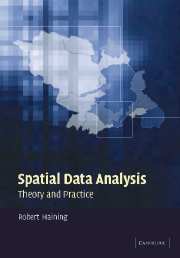Book contents
- Frontmatter
- Contents
- Preface
- Acknowledgements
- Introduction
- Part A The context for spatial data analysis
- 1 Spatial data analysis: scientific and policy context
- 2 The nature of spatial data
- Part B Spatial data: obtaining data and quality issues
- Part C The exploratory analysis of spatial data
- Part D Hypothesis testing and spatial autocorrelation
- Part E Modelling spatial data
- Appendix I Software
- Appendix II Cambridgeshire lung cancer data
- Appendix III Sheffield burglary data
- Appendix IV Children excluded from school: Sheffield
- References
- Index
2 - The nature of spatial data
Published online by Cambridge University Press: 06 July 2010
- Frontmatter
- Contents
- Preface
- Acknowledgements
- Introduction
- Part A The context for spatial data analysis
- 1 Spatial data analysis: scientific and policy context
- 2 The nature of spatial data
- Part B Spatial data: obtaining data and quality issues
- Part C The exploratory analysis of spatial data
- Part D Hypothesis testing and spatial autocorrelation
- Part E Modelling spatial data
- Appendix I Software
- Appendix II Cambridgeshire lung cancer data
- Appendix III Sheffield burglary data
- Appendix IV Children excluded from school: Sheffield
- References
- Index
Summary
This chapter discusses the nature of spatial data. All the analytical techniques in this book use a space-(time-) attribute data matrix (see the introduction). This matrix is the end product of a process of construction that starts from a conceptualization of geographical reality. What is it necessary to know about the relationship between that reality and the data matrix as a representation of that reality so far as the conduct of analysis is concerned and the interpretation of results?
There are a number of steps involved in specifying this relationship (see, e.g., Longley et al., 2001; Mark, 1999). First there is a process of conceptualizing the real world. This process extends to the identification of those fundamental properties that are relevant to the application. Such fundamental properties relate both to entities (‘things in the real world’) and the spatial relationships between entities. In the context of spatial data analysis spatial dependence in attribute values is considered as a fundamental property. Second, a data matrix acquires properties that may distance it from the real world as a consequence of representational choices. These are the decisions made about what to include in the data matrix and in what form, usually for the purpose of storing the data in a computer. Decisions must be taken, for example on spatial scale or level of spatial aggregation and the geometric class (points, lines, areas or surfaces) used to represent geographical entities.
- Type
- Chapter
- Information
- Spatial Data AnalysisTheory and Practice, pp. 43 - 88Publisher: Cambridge University PressPrint publication year: 2003
- 1
- Cited by



